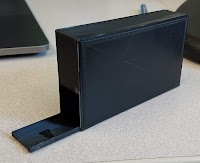 |
| Fluorimeter Design Sketch |
Backing up for a moment, let's see what a fluorimeter is actually for:
(via Wikipedia) A fluorometer or fluorimeter is a device used to measure parameters of fluorescence: its intensity and wavelength distribution of emission spectrum after excitation by a certain spectrum of light. These parameters are used to identify the presence and the amount of specific molecules in a medium. Modern fluorometers are capable of detecting fluorescent molecule concentrations as low as 1 part per trillion.
(via Wikipedia) A fluorometer or fluorimeter is a device used to measure parameters of fluorescence: its intensity and wavelength distribution of emission spectrum after excitation by a certain spectrum of light. These parameters are used to identify the presence and the amount of specific molecules in a medium. Modern fluorometers are capable of detecting fluorescent molecule concentrations as low as 1 part per trillion.
An everyday example of fluorimeter use is in the dairy industry where fluorimetry is used to verify successful pasteurization of milk. If the milk glows, it's not pasteurized!
I introduced the students to Tinkercad, a beginner-level, but capable online 3D modeling program. After a few iterations and modifications we were able to design the fluorimeter housing to hold a laser and a special lens adapter.
 |
| 3D Model -- Fluorimeter Housing |
 |
| The 3D printed version |
The students presented and demonstrated the fluorimeter/smart phone combo for their final chemistry lab this week. Look for future updates with photos of the device at work.
No comments:
Post a Comment